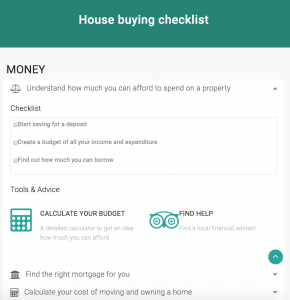The essential house viewing checklist
It’s easy to fall in love with a property, but whether you are a first-time buyer or an existing homeowner, you need to view your potential new home with a critical eye.
After all, this is a big investment – this could be your home for many years to come.
Our ultimate house viewing checklist will help you get the most out of viewing a property, step by step.
Step 1 – Before the viewing
Do your homework
You can find out a lot about a property before you view it. You can use Google maps in street view to see the area and work out where it is in relation to local amenities and community services.
You can access crime statistics, research your properties sale history and the valuations of all properties in the area.
Doing this research before viewing means that the time spent at the property is focused on the property itself.
Check out the local neighbourhood
Taking a walk or drive around the local area will help you determine whether you like the neighbourhood, or it could flag up some concerns.
Try and visit the area a few times, at different times of the day, to get a real picture of what it would be like to live there.
Save time with our property research reports
Key things to explore:
- Local amenities and services – where are the shops, the doctor’s surgery etc. Are there pubs or clubs nearby?
- Roads and traffic – how busy and noisy are they?
- Public transport – where is the train station and closest bus stop?
- Parking – is there enough? Are permits required?
- Schools – where are they?
Remember to consider each of these things and how they would impact you if you lived here.
Top tip: Practice your commute, especially if you are moving further away from work. You might think an extra 20 minutes will be fine but imagine how it could feel after you’ve done it five days a week for the next year or two.
Step 2 – The first viewing
You’ve booked your viewing and can’t wait to get inside to have a look around. It’s easy to get carried away when looking for your dream home but try to avoid letting your heart rule your head.
You want to make sure this home is right for you, so be prepared to seek out the problems, as well as identifying all the things that you love.
Prepare a checklist and make a list of questions. It’s easy to get swept away with the estate agents’ spiel and imagining yourself living there, so you need to keep yourself focused.
Take your time, don’t feel under pressure to rush and do explore the property alone without the estate agent hovering.
Create your first viewing checklist:
- List the things you need (storage, space for large furniture )
- List the things you want (a view, a big garden, off road parking )
- Note the room sizes in your current home to make easy comparisons
- Questions for the estate agent (see below).
Things to take with you:
- Your checklist
- Notebook
- Camera/phone (ask before taking photos)
- Tape measure to double check the accuracy of a floor plan.
- Torch (for dingy lofts and dark sheds!)
Questions to ask
Your first viewing is a great time to question the estate agent. The more information you have about the property the better, especially if you decide to make an offer.
Don’t be afraid to ask lots of questions; you’re about to make a big financial investment, so you need to be fully informed.
This list is not exhaustive, but it will help get you started.
- Why are they selling the property? When would they ideally like to move by? Have they found a property? If so, will you be part of a chain?
- Have there been many viewings? Has this led to any offers? Why were they rejected?
It’s the estate agents’ job to get the best price for the property, but they will also know if there is room to negotiate.
- What fixtures and fittings are included in the sale?
It’s always worth double-checking what the seller is taking with them – don’t assume light fittings and curtain poles will be left in place.
- What are the running costs like? Do they know what the council tax band is?
You need to be sure that the monthly bills will be manageable.
- Have there been any recent renovations or maintenance work?
If so, you may need to see the appropriate certificates for major things like windows, loft conversions or extensions before you buy.
- What are the neighbours like? Have there been any issues?
It’s wise to be aware of any disputes or issues before you decide to move in.
- Is the estate agent aware of any planning or development nearby?
If there is, ask what they think the impact will be on the property and the area.
- Is the property listed or in a conservation area? Is the property leasehold or freehold?
These are important questions as they will impact what you can and can’t do with the property and can create additional costs that you need to account for.
- If the property is leasehold how many years are left and what is the ground rent and service charge? If it’s a flat, how many of the other flats are owner occupiers and how many are tenants? How often are maintenance works carried out? Are maintenance and repair costs split equally, if not who pays what?
Step 3 – The second viewing
You’ve found somewhere you love, and now you need to make sure that it’s everything that you remember it to be. Second viewings are essential to double check that your first impressions are accurate.
It’s useful to take family or friends with you to provide an impartial opinion. You have just one key thing to remember – check and test everything!
Exterior checklist:
- Signs of damp and cracks
- Broken fascia, soffits and guttering
- The roof – tiles in place, straight chimney, secure lead flashing
- Windows – double glazed
- Security – property boundaries, doors and windows
- Property aspect – when does it get the sun?
- Neighbours – do they overlook the house/garden?
- Shed or exterior buildings
Interior checklist:
- Room sizes
- Working taps, hot water and water pressure
- Flushing toilets
- Working showers – electric or other
- Working light switches
- Windows open and close
- Signs of damp (see or smell) or mould
- Condensation
- Wall cracks
- Power sockets
- Phone points
- Storage space
- Exposed wires
- Boiler and central heating system
- Smoke alarms
- Fuse box
- Loft access
- Insulation
- Kitchen appliances
- Fireplaces
- Flooring (tiles, carpets )
Remember we tend to assume certain things, but are you sure there was a washing machine in the kitchen, was there a fridge/freezer or was it just a fridge, did you notice that one of the bedrooms was missing a ceiling light?
These checklists will help you identify cost-considerations and potential deal-breakers, so you know exactly what you would be buying.
Conduct your viewings systematically, and you will be able to make a confident and informed decision on making an offer.
Next Step
Plan buying a house with confidence using our complete house buying checklist.
Each step of the house buying process is covered in more detail along with help, advice and online tools.


